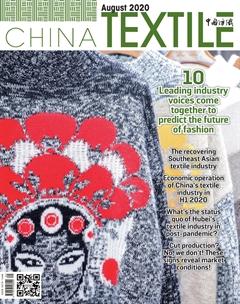Dear readers
The July-August edition of CHINA TEXTILE provides you with a broad swath of information relating to economic performance of different sectors from fiber to fashion in the official statistics to cover the first half of the year. Moreover, a series of reports are attainable to get a glimpse of the textile and fashion industry from the speakers in Brazil, China, France, Germany, India, Italy, Japan, Russia, The Netherlands, United Kingdom, USA at an online meeting organized by Intertek, the worlds largest consumer testing, inspection and certification group, to underpin the future of the fashion, with the participants weighing on the major mega trends that are set to reshape the industry post-pandemic. Also available in the new bimonthly edition is the subject matter for sustainability that is reinforced by even more demanding standards for quality assurance, safety, clean production, less consumption of energy and upgraded waste-water treatment.
The first six months is a milestone on seasonal basis that divides the whole year into two frames of time, more significantly is also the hallmark that made a turn for the better to present the positive 1.9% growth in Chinas textile and apparel export, the first time ever since the beginning of 2020 after so long a time of negative slogging.
While confidence is being resuscitated by the export recovery in international markets, a sizzling worry is also growing as we see textiles export runs faster than the apparel shipment with the former up by 24.8% and the latter down by 19.4%, a trend that threatens to dethrone China when the apparel export, the finished goods for addedvalue product, continues to decline to be dwarfed by the textiles, the upstream products in the industrial value chain, while the neighboring countries import fabrics from China to aggrandize the apparel export, prising the benefits away from Chinas long-time predominance in international markets. The first half of the year witnessed that trend to upend the apparel in export structure with $53.64 billion v.s. $77.16 billion, roughly in a 40% against 60% export share, which is nothing short of an upside down if we look over our shoulders to see the historical trends of textiles and apparel export over decades when the apparel export hovered around 60% - 80% in the total export share, far over the textiles. The latest data for January-July argue well for this trend that showed the export of textile growth by 35.8 percent, and the apparel decline by 13.8 percent, and the export share for apparel was 26% and the textiles 74% in RMB value terms.
What would be in store tomorrow if this apparel-thin and textiles-thick export pattern stay steadfast? This is definitely not the kind of sustainability we set for. While we are talking enthusiastically about the sustainable growth, it is not confined to the subject matter of environmental protection geared up in the toolkit of technology, standards, law, quick-to-react mechanism and highly efficient synergetic operation system; it is nevertheless the strategic consideration of industrial security for the country. A significantly ambitious strategy calling for a bigger domestic circulation, coupled with dual-cycle markets both at home and abroad, is headlined in media and official documents, and is most likely to be set for the policy line for the economic roadmap in the next five years which is a planned period for the 14th Five-Year Program for Economic and Social Development in China. Would the apparel export businesses see the silver lining in this new horizon against the clouds of export recession?
ZHAO Hong Editor-in-Chief
August, 2020
- China Textile的其它文章
- 10 Leading industry voices come together to predict the future of fashion
- The recovering Southeast Asian textile industry
- 97 percent Bangladeshi products to get duty-free access to China,and India to lose its competitive advantage
- Vietnam market demand will resume,but the whole year exports may fall
- How about the textile and apparel industry in Cambodia,Myanmar,Laos and Thailand in the first half of the year?
- Analysis on the transfer trend of global textile and apparel industry chain

